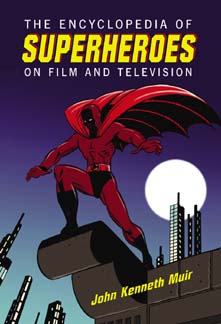|
June 2006
The Caves Have Ears in The Descent
Media Commentary by John Kenneth Muir
 Thanks to the auspices of a good friend who shares my love of horror films, I just had the pleasure of watching (or I should say…experiencing) The Descent, the best and scariest horror film I’ve seen in the last five years. Thanks to the auspices of a good friend who shares my love of horror films, I just had the pleasure of watching (or I should say…experiencing) The Descent, the best and scariest horror film I’ve seen in the last five years.
I try not to depend heavily on hyperbole for my movie reviews. That gets old…fast. When a movie’s good, I say so…but I also have rigorous high standards, especially for genre films. It always bothers me that critics and audiences mistake horror for a gutter genre; one that’s just about blood or violence or gore. On the contrary, I believe the horror film is alone among genres in that it can betranscendent…at least the really good ones. Good horror isn’t about blood; it’s aboutcatharsis; it isn’t about shouting “boo,” it’s about confronting the very things inside our psyches that we hide and bury and fear confronting. In its very best outings, horror can also be the most moral and complex of genres.
So now you know where I come from when I wrote above that The Descent is the best horror film I’ve seen in the twenty-first century. It’s equally strong on substance and style, and the film cleverly expresses some powerful ideas about this crazy dance we humans perform during our time on the mortal coil. If that description sounds like your cup of tea, The Descent is your kind of movie.
The Descent is the riveting and harrowing story of several athletic young sportswomen (of the extreme variety), led by the confident Juno (Natalie Mendoza) who unwisely choose to explore a cave in my neck of the woods, in backwoods North Carolina. It’s an unexplored cave, but Juno is arrogant. So much so that she hasn’t even brought along her maps or books…a fact which she hides from her gung-ho buddies, including Sarah (Shauna MacDonald), who has recently survived a personal tragedy. Juno also hasn’t filed a descent plan with local authorities…so one really knows where the women have gone. If that sounds like a recipe for disaster to you, well, it is.
What terrors befall this group of unfortunate young women in that dark, increasingly claustrophobic cave may remind you a bit of John Boorman’s devastating, high-impact white-water rafting effort Deliverance (1972), which The Descent cleverly and quickly references in its first moments. Deliverance was another story about vacationers reckoning with their own arrogance as well as hostile locals. Only here the locals are monstrous darkness-dwellers: sub-human things that lurk and leap in the darkest corners of these long unexplored caverns. And…there may be hundreds of them.
Written and directed with exceptional skill by Neill Marshall, The Descent rarely missteps. The film’s early moments chart the nature of Sarah’s excruciating personal pain, and forecast her pain to come in that dead-end cave. There’s an early sequence set in an hospital that proceeds with breathless, accelerating fear as Sarah runs and runs down a seemingly endless corridors, the lights going out all around her, plunging her into quadrant after quadrant of impenetrable darkness. This is a perfect foreshadowing of that cavern in North Carolina, but here it’s a both a technological cave of “fear” and an internal one too, the dark cave of the mind during a human crisis.
As you might guess, confined spaces and darkness play a big role in this film’s sub-textual gestalt, and Marshall makes all the pertinent connections. If you’ve ever been afraid of the dark (and who hasn’t?) you’ll be unnerved from the film’s very first sequence and then held in terror’s tight, vise-like grip to the last, breathless apex.
After some rudimentary character-building moments in a rented cabin in Appalachia, where the young women reunite, The Descent sends its dramatis personae off to the mountains. This section of The Descent is particularly canny for two reasons. First, the characters—though boisterous—are depicted in broad but understandable terms as real people. No one says anything particularly memorable, but that’s right…the realism factor is high; and cheesy characters or overly dramatic situations would make the film laughable.
Instead, the characters are differentiated well, but there’s no bogus theatrical “arc” (like Langdon’s fear of elevators in The Da Vinci Code). The overwhelming sense is simply that these are the people we’re with: general enough that we can identify with them but also basic enough that we fill in the psychological blanks; we insert our own fears and feelings into these character vessels…and that’s another secret of good horror. The characters can’t be ciphers, but they have to be simple enough that we can imagine ourselves in their shoes. The Descent finds that perfect balance.
The second aspect of this early sequence that makes it feel so powerfully ominous is the splendid cinematic style. Taking a cue from Tobe Hooper’s Texas Chain Saw Massacre (1974) play book, Marshall deploys a variety of extreme long shots to express the idea of man being “small” and therefor insignificant against the backdrop of nature. We see various carefully-crafted shots of the sports utility vehicle navigating the curving, winding roads carved out of tree-laden mountainside, and you may also be reminded of those early shots in The Shining (1980). But the overhead shots (which are beautifully rendered thanks to some fine aerial photography) in The Descent also capture the idea of an unfeeling God’s eye looking upon an ant-hill; dispassionately gazing upon the comings and goings of man with no comment and no sympathy.
Once in the dark and frightening cave, Marshall adapts his directorial modus operandi appropriately for the setting. Tight framing replaces the expansive overhead and extreme long shots. A sense of encroaching claustrophobia becomes unbearable as the characters - now trapped two miles beneath the surface of the Earth—wriggle and twist their way through tunnels just barely wide enough to accommodate their girth. They can’t see more than a few feet in front of them, and are unable to turn around and go back. This is a (tight) one way trip into a realm of mystery and terror…
One unfortunate character, Sarah, becomes stuck in one such channel for a time, her arms hinged and pinned in the unforgiving rock. She begins to panic, her breathing growing steadily faster. If you’ve ever nursed a fear about being buried alive, or simply felt the tightness of a claustrophobia moment, this sequence will literally make you crawl out of your skin. It became so palpably disturbing for me (a vet with these films…) that I felt jittery and couldn’t sit still. My friend’s sweet wife actually had to leave the room at this juncture. “I can’t watch this,” she said. Yes, it’s that disturbing, and director Marshall milks the moment of paralysis beyond the point of discomfort, into the realm of sheer, inescapable horror. It’s a bravura achievement.
Only in the last section of The Descent does Marshall introduce his “bad guys,” the sub-human, carnivorous bat creatures who roam the dead-ends and cul-de-sacs of that pitch-black cave. His first “reveal” of these monsters will go down as a classic in genre history. It’s every bit the equal of any John Carpenter or Wes Craven moment. It will jolt you out of your seat, and may induce coronary in some. It relies on the old trick in horror movies of unexpected “proximity” and also dramatic shifts in lighting scheme. In pitch black, there’s nothing… but through the infra-red gaze of a handycam LED screen…the monster is already on top of the explorers. It’s chilling stuff, and visually explosive.
Like Deliverance, and other “savage” films of the 1970s, The Descent ends with the dedicated clash of two disparate cultures, each vying for superiority in a contained space, a wild terrain. If it’s not explicitly The Hills Have Eyes (1977), then it’s The Caves Have Ears (the creatures are blind and communicate with clicks and croaks). True to the lineage of such disco-decade cinematic efforts, each human being trapped in this metaphorical and literal underworld is tested through the crucible of combat. As you might expect, some characters find their inner strength; others fall apart. Some are tragically taken out of the game early, injured by falls or taken unawares and eaten alive (before our very eyes…) by hordes of these things.
One character, perhaps reflecting Apocalypse Now (1979), goes “native”…ultimately to the detriment of the other survivors. Also, like the best of such horror films, a seemingly preposterous situation serves as an efficient lens through which to view every aspect of human nature, and that’s the real reason why The Descent emerges such a great film. It covers issues like denial and desperation (particularly in a climactic hallucination sequence), but also acceptance (in the last few, valedictory shots), and other aspects of our delicate mortality.
Some horror fans could likely care less about such carefully threaded thematic elements, but they will love The Descent nonetheless, because it does pass the ultimate benchmark: It is unfailingly scary. I just finished watching 328 horror movies for my upcoming book, Horror Films of the 1980s, and I can tell you unequivocally…only The Descent provoked nightmares. Marshall’s film unnerved me from start to finish; on the ride home to my own house in the pitch black of night; and then again as I placed my head on the pillow and sought to escape from its unforgettable imagery in slumber.
If you don’t want to be terrified to your core; don’t see The Descent, which will be released in American theaters in August. However, if you miss the frenetic, heart-pounding madness of such classics as Deliverance, The Texas Chainsaw Massacre andThe Hills Have Eyes, you will welcome this new vision of terror with open arms. It’s a descent into a cave; into human psychology; and into levels of Hell—personal and environmental—but despite the metaphor of falling down further and further into a nightmare, the film itself may represent the pinnacle, the high point, of the 21st century form.
|




